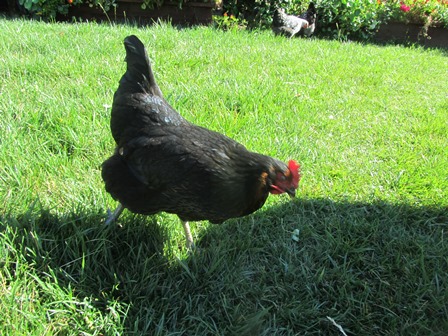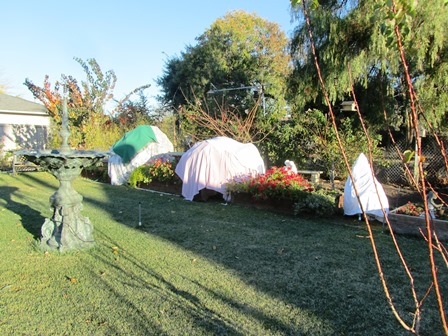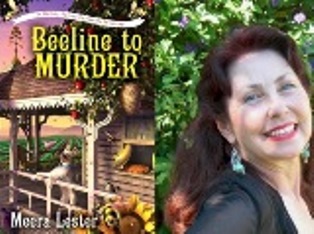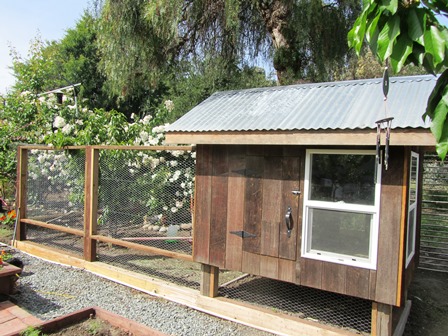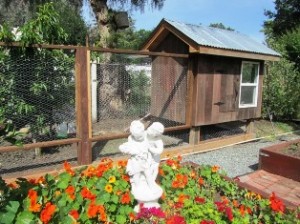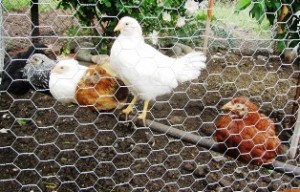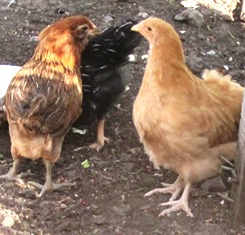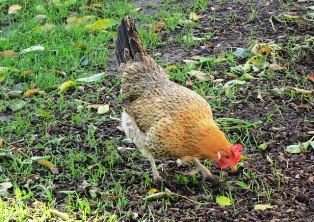Eggs Don’t Get Fresher Than This!
The chickens were making a ruckus this morning just after sunup. They often do that when one of them is occupying a favorite nesting box and another wants in. Finally, I got up and trudged out to the chicken house.
When I let the chickens out of their house into their run today, one of them–the Black Sex Link hen (Blacky)–hadn’t quite finished laying her egg.
But as they always do, the hens made a run for it when the door opened. Blacky included. They hopped out and followed the Rhode Island Red in the pursuit of grass and worms and other things chickens like to eat. That’s when I noticed Blacky waddling along, trailing the other hens. That’s unusual for her.
It soon became clear why. She had a fully formed brown egg halfway out. I’ve seen some strange things since raising these hens from when they were baby chicks housed in a big tub in my kitchen. But this was the strangest.
I reached down to see about giving the egg a bit of pull when Blacky decided to push. I caught the egg before it hit the ground.
* * *
If you enjoy reading about gardening, keeping bees, raising chickens, and creating delicious recipes, you might want to check out my novels from Kensington Publishing.
The Henny Penny Farmette series of cozy mysteries are available online and in tradition bookstores everywhere, in hardcover, kindle, and mass market paperback formats.
The MURDER OF A QUEEN BEE will be released in hardcover October 1.
A Prowling Raccoon Looking for a Warm Chicken Dinner
My farmette looks like some kind of ghostly haunt after sunset. That’s because of all the bed linen I’ve draped over citrus trees and frost-sensitive plants. On moonless nights, the backyard looks like a gathering of ghosts illuminated by the warming lamp in hanging in the hen house.
That heat lamp splays light across the back of the property. I didn’t realize right away that the claw marks in the dirt near the chicken run are from a large raccoon who, thanks to the light, now knows exactly where to find the chickens and has come prowling over the last few nights. My locks and the buried wire fencing of the chicken run are keeping the hens safe.
For the last few mornings, the water in the Italian fountain (the motor is turned off now) has been frozen and doesn’t thaw until mid-morning. Still, I see wild birds bathing in it. And we have plenty of wild birds now, thanks to twenty pounds of bird seed we’ve poured into feeders around the property.
I’m looking forward to the weather changing again in a couple of days–rain is on the way. The last storm brought a new blooms to the roses and caused the daffodils and some summer tulips to push up green shoots.
Since some of my trees perform better with a good winter chilling, I feel obliged to appreciate the cold. Besides, I can stay inside and bake, read books and seed catalogs, and write on my third cozy mystery novel.
If you enjoy reading about farmette life, you might like the farmette milieu featured in A Beeline to Murder, the first book in my Henny Penny Farmette series of cozy mysteries. See, http://tinyurl.com/p8d6owd
Blankets for Trees & Bees on Frosty Nights
I don’t like to take chances with my citrus trees when overnight temperatures drop to near freezing. I cover them with sheets and blankets.
My hives are in a wooden shelter with a tin roof and the back side open, so I can work without any encumbrance. But I don’t want the bees to have to work harder to keep the hive warm for the queen and babies, so I throw some blankets over my beehives, too.
Also, on particularly cold nights, I hang a warming lamp in my chicken house. My rule of thumb for my hens is when overnight temperatures are expected to drop below 45 degrees, I turn on the lamp so the hens aren’t stressed.
An advantage of hanging a heat lamp in the chicken house is to foster egg laying at time when shorter days of light slows egg production. The heat lamp makes light available to the chickens for a much longer period.
Dealing with a Flock of Stressed-Out, Feathered-Out Chicks
Now that the weather has turned warm here in Northern California, I have moved my baby chicks from the huge box in my kitchen to our newly constructed chicken house. I don’t know for certain, but I think they were feeling stressed out in the box and I was stressed from the noise and their behaviors of pecking each other and trying to fly out of the box.
The hen house has two windows that open and close for ventilation, nesting boxes, a front door for my access, a back exit door with stairs for the chickens to enter and leave, and a couple of perches inside and out. We wired a poultry screen over the top of the chicken run because of the predatory habits of local hawks.
Our chicks range in age from eight and ten weeks and are all feathered out. I feed them medicated crumble and provide fresh water daily. To ensure strong legs, I cover the chicken house floor with a bed of dried, crushed corn cob. I also have stuffed straw into the three nesting boxes so that when the chickens are ready to begin laying, they’ll have a bed ready.
The chicks are growing so fast, their girth and height seems to double every week. The bulk of their diet is crumble, but with an occasional treat such as shredded fresh lettuce and spinach leaves. Their activities and often-flighty behaviors are notable for chickens. They take dust baths, scratch the earth for grubs and worms, run at each other while seemingly intent on crashing only to avert at the last minute, perch together to roost, and peck their housemates. Oh, the pecking!
Guess which chicken is the most aggressive pecker from my flock that includes White Leghorn, Silver-Laced Wyandotte, Buff Orpington, Rhode Island Red, Black Sex Link, and an Ameraucana. Turns out,in my flock, the most aggression is shown by the Buff Orpington.
From day one, “Buffy” has pecked the quiet Ameraucana. Before the Ameraucana had feathered out, blood would flow from her back from Buffy’s senseless pecking. I tried to separate them, giving Buffy time outs and hoping to stop her behavior. It seemed to work . . . or, maybe I was just imagining it was.
I placed a dab of antibiotic cream on the back of the Ameraucana and within days, her pecking wound healed and now she’s feathered again over the wound. The move to the chicken house reduced the stress of living out of a box in the kitchen. Now the chickens seem to get along fine, even enjoying their life in the hen house.
Last night, Buff huddled up next to the Ameraucana on the roost and this morning I saw the two of them taking a dust bath together. Chicken stress relief. My stress relief. It’s a beautiful thing!
If Your Chickens Aren’t Cold Hardy, What Can You Do?
Chickens that can tolerate extreme cold are considered cold-hardy. The Dominique, Hamburg, Langshan, Sussex, and Wyandotte breeds are considered chill tolerant (even cold-hardy) but breeds such as Crevecoeur and Catalana are less tolerant of temperature extremes. So are Bantams and some breeds with large, single combs.
The chickens generate body heat that helps alleviate the cold temperature of a coop. They also wear feathered coats and will huddle together for warmth. A hen house that has insulation and perhaps a south-facing window that captures the warmth of a winter sun can also mitigate extreme cold.
Still, if you live in an area where the temps are below freezing, where it snows, and where the wind contributes to the chill, you might want to hang an ordinary light bulb (40-60 watts) or a 50-watt red bulb if you worry about frost-bitten chickens on those coldest nights.
Put that lamp on a timer. But beware of hanging any electric light that could get knocked down. It could set your coop on fire. And cold-tolerant breeds probably don’t need the extra heat anyway.
Perhaps equally, if not more, important are the chickens’ need for fresh water, ventilation, and a dry environment during winter. You don’t want the chickens roosting in a draft, but you do need ventilation in the coop, for example, via egg-access doors, windows, or ventilation holes with screens. They also need a dry environment.
If the coop isn’t insulated, you might stack bales of straw or hay along the walls and scatter pine shavings if your coop has an earthen floor that becomes cold or frozen.

This chicken house has egg access doors, a human door, a window, and is insulated; the art is optional.
Cold-hardy chickens probably will make it through most frosty nights with few to no problems. Your best tool is your ability to observe your chickens for problems. Oh, and you might want to place a thermometer inside the coop for an accurate measurement about how cold it really gets when the ladies (and rooster, too) are all inside.
Don’t judge your chickens’ endurance for cold by your own.
 Facebook
Facebook Goodreads
Goodreads LinkedIn
LinkedIn Meera Lester
Meera Lester Twitter
Twitter





